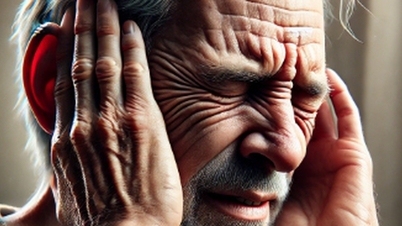A 21-year-old man arrived at Military Hospital 175 with weak limbs, numbness, and an inability to walk after inhaling 1,000 laughing gas balloons in a month.

Neurologists at Military Hospital 175 participate in treating a patient with complications from inhaling laughing gas - Photo: Provided by the hospital
On February 17, Military Hospital 175 said that in January 2025, the hospital's neurology department consecutively admitted three young patients in critical condition, related to laughing gas abuse.
A typical case is the case of female patient VMC (21 years old) who was hospitalized in critical condition. The patient had a history of using laughing gas and stimulants, and recently had a tendency to become seriously dependent.
Three days before being hospitalized, the patient used laughing gas at a high frequency, leading to loss of language and extensive brain damage.
Brain MRI results showed diffuse damage to both hemispheres and corpus callosum - a sign of severe neurological damage that can leave long-term sequelae.
Just one week later, male patient PHK (21 years old) was also hospitalized with symptoms of numbness, weakness in all four limbs, and inability to walk on his own.
The patient had a history of using an alarming amount of laughing gas up to 1,000 balls/month.
Previously, the patient had been hospitalized for treatment but continued to use due to dependence and work pressure.
In another case, male patient V.D.M. (24 years old) was hospitalized with similar symptoms to patient K. including movement and sensory disorders.
The patient had a history of continuous use of laughing gas for three months.
Spinal cord MRI results showed severe damage, accompanied by multiple abnormalities in blood tests.
All three patients responded relatively well to treatment, but the general prognosis was a risk of other neurological damage and permanent disability later on, as well as a risk of relapse due to the inability to break the dependence.
According to Dr. Hoang Tien Trong Nghia - Head of the Department of Neurology at Military Hospital 175, laughing gas N2O is a colorless, slightly sweet gas, used in medicine for anesthesia and pain relief purposes.
However, this gas is being abused as a stimulant, laughing gas creates a feeling of excitement, "high" and uncontrollable laughter. The mechanism of action of laughing gas has a direct impact on the central nervous system.
Regular use can lead to many serious consequences including vitamin B12 deficiency, damage to the spinal cord and peripheral nervous system, mental disorders and cardiovascular problems.
"Most patients said they inhaled laughing gas for entertainment, relaxation or because of addiction. Many patients have high levels of education but are still subjective, underestimating the harmful effects of laughing gas, leading to abuse and leaving serious health consequences.
This is a substance that has the risk of being addictive and creating hallucinations, with a tendency to increase the dose over time," Dr. Nghia emphasized.
Source: https://tuoitre.vn/hit-1-000-qua-bong-cuoi-trong-1-thang-nam-thanh-nien-yeu-tu-chi-liet-nguoi-20250217171457316.htm



![[Photo] Party and State leaders attend the special art program "You are Ho Chi Minh"](https://vphoto.vietnam.vn/thumb/1200x675/vietnam/resource/IMAGE/2025/5/18/6895913f94fd4c51aa4564ab14c3f250)
![[Photo] Many young people patiently lined up under the hot sun to receive a special supplement from Nhan Dan Newspaper.](https://vphoto.vietnam.vn/thumb/1200x675/vietnam/resource/IMAGE/2025/5/18/6f19d322f9364f0ebb6fbfe9377842d3)


![[Photo] Ready for the top competitions of Vietnamese table tennis](https://vphoto.vietnam.vn/thumb/1200x675/vietnam/resource/IMAGE/2025/5/18/9c547c497c5a4ade8f98c8e7d44f5a41)



















































































Comment (0)